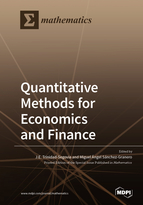Quantitative Methods for Economics and Finance
A special issue of Mathematics (ISSN 2227-7390). This special issue belongs to the section "Financial Mathematics".
Deadline for manuscript submissions: closed (30 September 2020) | Viewed by 71559
Special Issue Editors
Interests: long memory; portfolio theory; fractal dimension
Special Issues, Collections and Topics in MDPI journals
Interests: fractal structures; fractal dimension; Hurst exponent; finance; asymmetric topology
Special Issues, Collections and Topics in MDPI journals
Special Issue Information
Dear Colleagues,
Since the mid-twentieth century, it has been clear that the more classical mathematical models were not enough to explain the complexity of the financial and economic series. Since then, the effort to develop new tools and mathematical models for their application to economics and finance has been remarkable. However, it is still necessary to continue developing new tools, as well as continue studying the latest tools developed for the study of the financial and economic series. These tools can come from techniques and models taken from physics or from new branches of mathematics such as fractals, dynamical systems, or new statistical techniques such as big data.
The purpose of this Special Issue is to gather a collection of articles reflecting the latest developments in different fields of economics and finance where mathematics plays an important role.
Prof. Dr. J.E. Trinidad-Segovia
Prof. Dr. Miguel Ángel Sánchez-Granero
Guest Editors
Manuscript Submission Information
Manuscripts should be submitted online at www.mdpi.com by registering and logging in to this website. Once you are registered, click here to go to the submission form. Manuscripts can be submitted until the deadline. All submissions that pass pre-check are peer-reviewed. Accepted papers will be published continuously in the journal (as soon as accepted) and will be listed together on the special issue website. Research articles, review articles as well as short communications are invited. For planned papers, a title and short abstract (about 100 words) can be sent to the Editorial Office for announcement on this website.
Submitted manuscripts should not have been published previously, nor be under consideration for publication elsewhere (except conference proceedings papers). All manuscripts are thoroughly refereed through a single-blind peer-review process. A guide for authors and other relevant information for submission of manuscripts is available on the Instructions for Authors page. Mathematics is an international peer-reviewed open access semimonthly journal published by MDPI.
Please visit the Instructions for Authors page before submitting a manuscript. The Article Processing Charge (APC) for publication in this open access journal is 2600 CHF (Swiss Francs). Submitted papers should be well formatted and use good English. Authors may use MDPI's English editing service prior to publication or during author revisions.
Keywords
- Financial series
- Portfolio theory
- Factor models
- Volatility modeling
- Quantitative methods
- Long memory
- Computational finance
- Statistical arbitrage







